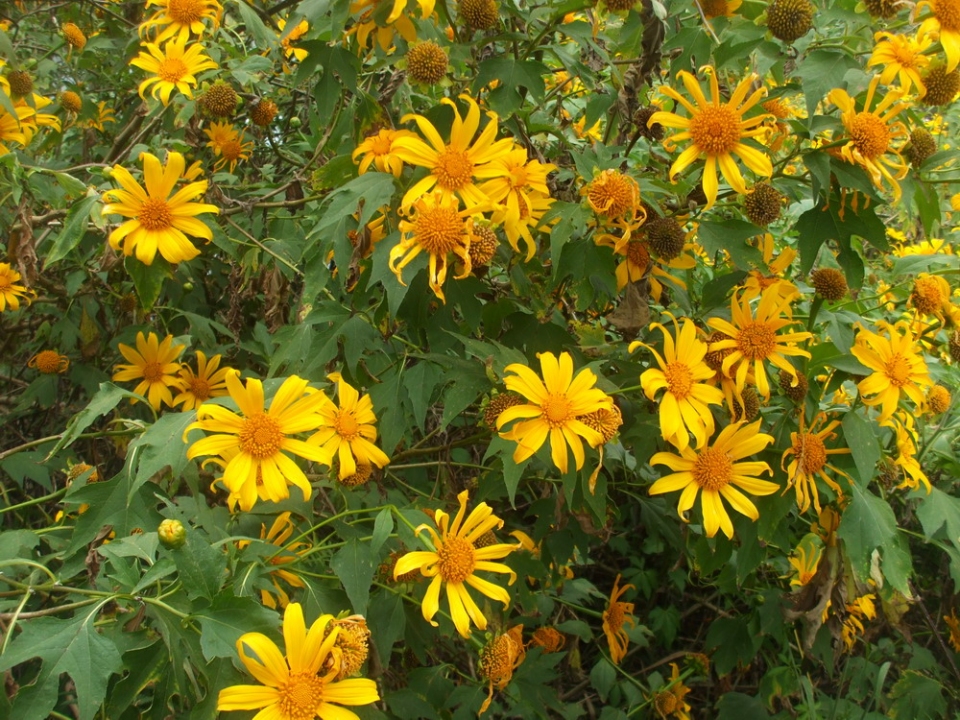Tithonia diversifolia

|
|||
Tithonia diversifolia Common Names: Tree Marigold, Mexican Sunflower, Wild
Sunflower, Japanese Sunflower Scientific
Classification Kingdom: Plantae Clade: Tracheophytes Clade: Angiosperms Clade: Eudicots Order: Asterales Family: Asteraceae Genus: Tithonia Species: T. diversifolia Binomial Name: Tithonia diversifolia (Hemsl.) A.Gray Synonyms: Mirasolia diversifolia Hemsl., Polymnia diversifolia (Hemsl.) Benth. & Hook.f. ex
B.D.Jacks. Morphological Description Tithonia diversifolia, commonly known as Mexican Sunflower or Tree Marigold, is a
perennial shrub typically growing to 1.5–3 m in height, occasionally reaching 5
m. It is characterized by: · Stems: Hollow, woody, erect, 2–5 cm in diameter, often branched,
with a rough texture · Leaves: Ovate to obovate, deeply lobed (3–7 lobes), 6–23 cm long,
3–18 cm wide, dark green, hairy beneath · Flowers: Bright yellow, daisy-like, 10–15 cm across, with 10–15 ray florets
(3–5 cm long) and numerous disc florets, blooming year-round · Fruit: Achene, small (4–6 mm long), brown, with a pappus of scales
aiding wind dispersal Distribution and Habitat Tithonia diversifolia is native to Mexico and Central America but has naturalized
across tropical and subtropical regions, including Africa (e.g., Nigeria,
Kenya), Asia (e.g., Taiwan, Philippines), and Australia. It thrives in: · Habitats: Roadsides, abandoned fields, disturbed areas, and forest
edges · Climate: Seasonally dry tropical climates, with temperatures of
15–35°C and rainfall of 800–2,000 mm annually · Soil Conditions: Well-drained sandy or loamy soils (pH
5.0–7.5), moderately drought-resistant · Light: Full sun to partial shade, often invasive in open areas Its adaptability has
made it both a valuable resource and an invasive species (Jama et al., 2000). Ethnopharmacology Tithonia diversifolia, commonly known as Mexican sunflower, is a medicinal plant widely
recognized for its extensive use in traditional medicine across tropical
regions. It exhibits a broad spectrum of pharmacological activities, including
antidiabetic, anti-inflammatory, antimicrobial, antimalarial, analgesic,
antipyretic, and antioxidant properties. The leaves are especially used in
herbal preparations to manage diabetes, malaria, wounds, and gastrointestinal
disorders. Scientific studies have demonstrated that extracts from the plant
significantly reduce blood glucose levels, inhibit the growth of various
pathogens, and modulate inflammatory responses. The presence of active
phytochemicals such as flavonoids, sesquiterpene lactones, tannins, saponins,
and phenolic compounds contributes to these therapeutic effects. Additionally,
animal studies have confirmed its efficacy in pain relief and fever reduction,
as well as its potential role in cancer prevention through apoptosis induction
and oxidative stress modulation. Despite its potent biological activities, more
clinical trials are needed to fully validate its safety and efficacy in humans · Anti-inflammatory
and Analgesic Effects:
Studies have demonstrated that leaf extracts exhibit significant
anti-inflammatory and analgesic properties, supporting their traditional use in
treating painful inflammatory conditions(Owoyele et al., 2004). · Antimicrobial
Activity: Crude extracts from the
leaves, stems, and roots have shown antimicrobial efficacy against various
bacterial and fungal pathogens, attributed to the presence of terpenoids and
flavonoids(Merciline, et al.,2020) · Antimalarial
and Antidiabetic Properties: Research indicates potential antimalarial activity, with studies
showing efficacy in vivo. Additionally, extracts have been observed to exert
antidiabetic effects in diabetic mice models. ( Wikipedia) ⚠ Toxicity Profile: While T. diversifolia exhibits various medicinal
properties, studies have also highlighted potential toxic effects, particularly
with prolonged use or high doses. Repeated-dose toxicity studies in Wistar rats
revealed that extracts rich in sesquiterpene lactones (STLs) and chlorogenic
acid derivatives (CAs) can cause liver and kidney damage. The aqueous extract
was relatively safe at doses below 100 mg/kg, but higher doses led to adverse
effects.( Passoni, et al.,2013).Dihydro-p-coumaric acid, isolated from the
leaves, was tested for acute and sub-acute toxicity in BALB/c mice. The
compound was generally safe up to 1,600 mg/kg body weight, with only slight
hepatotoxicity observed at higher doses, as indicated by elevated liver
enzymes. (Devi, et al.,2022}). Additional Uses · Agriculture: Green manure boosts soil phosphorus (up to 0.37% dry
weight), used in Kenya (Jama et al., 2000) · Erosion Control: Dense growth stabilizes slopes in Nigeria · Fodder: Leaves (20% protein) fed to livestock in dry seasons · Fuelwood: Woody stems used in rural households · Ornamental: Bright flowers enhance gardens worldwide · Pesticide: Leaf extracts repel aphids and beetles on crops (Tembo et
al., 2018) References
External Links More Pictures
| Compounds of Tithonia diversifolia |
|
|
| References |